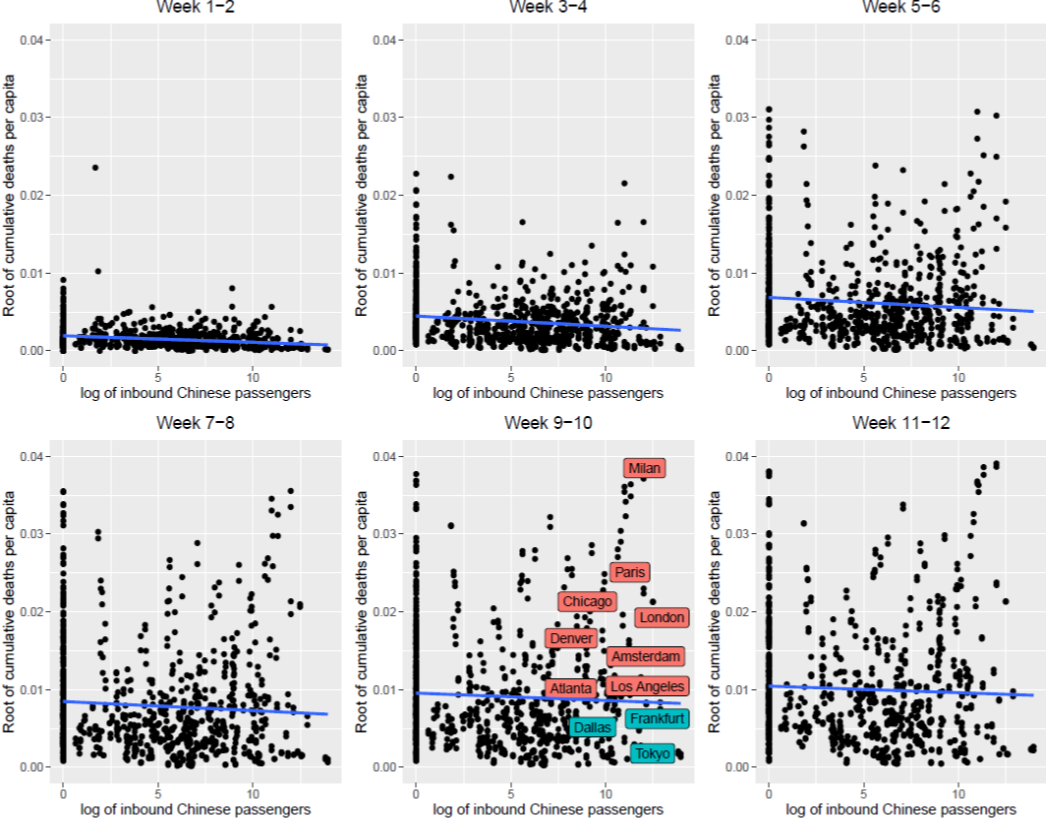
Read more
Blog, Public Attitudes
What’s in a name? Immigrant’s name choices as a signal of belonging
According to a 2018 pan-EU Eurobarometer survey, 91 per cent of Europeans think it is important that immigrants are committed to the values and norms of their host society. At the same time, the...
In his 2007 best-seller, The Black Swan, Nassim Taleb wrote: ‘As we travel more on this planet, epidemics will be more acute […] and the successful killer will spread vastly more effectively’. Was this sentence, which has been reiterated by the media since the early days of Covid-19, prophetic of what took place globally in 2020? Recent research seems to suggest that the answer is ‘no’.
While epidemiologists have long argued that globalization and the rise of human mobility boost the diffusion of diseases across national borders, a paper just published by Michael A. Clemens and Thomas Ginn finds that the acceleration of global travel does not trigger more impactful epidemics. Their study focuses on four pandemics in three different centuries: the influenzas that began in 1889, 1918, 1957, and 2009. According to their estimates, a 50 percent reduction in pre-pandemic global mobility would have only delayed the spread of the virus outside of its source location by no more than 1–2 weeks on average. More importantly, such a radical cut in international travel would have produced no detectable reduction in final mortality. The harm caused by pandemics is independent of the scope and the size of pre-existing worldwide travel flows.
An ongoing research project at MPC (The Airport Factor: Assessing the Impact of International and National Aviation Mobility on the Spread of Covid-19) is currently assessing the effect of air travel in the last quarter of 2019 and during the first semester of 2020 on Covid-19 mortality in 39 countries in five continents (Europe, the Americas, Asia, Africa, and Oceania). The aim of this project is to measure the net effect of other plausible factors that are known to foster the incidence of the disease: geo-seasonal factors (such as local temperature), demographic factors (such as the seniority of the population), health conditions (such as the prevalence of obesity), and the adoption of non pharmaceutical interventions (such as lockdowns and travel bans, as captured by the Oxford COVID-19 Government Response Tracker). These indicators were collected at the subnational level, for a total of 490 regions.
Figure 1. The correlation between the volume of inbound air passengers in late 2019 (logarithm) and the cumulative number of Covid-19 deaths per capita (square root) in the first 12 weeks of spread of the pandemic in 430 sub-national areas (39 countries)
Source: Airport Factor Covid-19 Dataset.
Figure 1 plots the correlations between cumulative deaths from Covid-19 per capita in each region and the number of inbound passengers at local airports (in the last quarter of 2019) across the first twelve weeks following the outbreak of the epidemic in the area (i.e., since the first registered Covid-19 death). While the victims of the virus rose exponentially week after week, the increase in deaths was largely independent of the amount of air passengers that had flown to each area previously. The figure also indicates the ten largest airports by passenger traffic, revealing a huge variation between the region around Milan (which was one of the most affected regions worldwide) and Tokyo (among the least affected). In more complex modelling, we regressed the log of the number of Covid-related deaths per capita per week on an extensive list of potential predictors other than travel. We found that at no point did the volume of pre-pandemic inbound air travelers have a significant effect on the number of Covid-19 casualties.
Further, we tested whether a higher volume of inbound air passengers triggered earlier outbreaks of Covid-19 – it did not.
Figure 2. The correlation between the volume of inbound air passengers from China in late 2019 (logarithm) and the cumulative number of Covid-19 deaths per capita (square root) in the first 12 weeks of spread of the pandemic in 430 sub-national areas (39 countries)
Source: Airport Factor Covid-19 Dataset.
A possible objection to our findings is that what really mattered for the spread of the virus was the number of passengers coming from China, the first hotbed of Covid-19, as opposed to global passenger traffic. Figure 2, in fact, shows that this is not the case either. The cumulated number of deadly Covid-19 cases is not significantly correlated with the volume of inbound passengers flying in from Chinese airports to the rest of the world. A large number of regions with no direct flight connections with China had a sizeable amount of victims, in spite of zero air passenger arrivals from China. This is visually shown by the quantity of cases on the left-hand side of each graph. Equally, the number of incoming passengers from China was not a significant predictor of the timing of the early outbreaks – that is, the calendar week of the year in which the first Covid-19 cases and deaths were reported.
“Air travel acts as a potential fuse, not the fuel of the virus.”
It is not the number of travelers but the policies put in place to manage their arrival that make a difference. Additional regressions, comparing the impact of the volume of inbound passengers (both before and during the pandemic) with other known predictors of the incidence of Covid-19 between April and July 2020, highlight that total travel bans significantly diminished the incidence of the virus three weeks later. In contrast, milder measures (like temperature control, quarantines of incoming passengers, or bans limited to some origins) had little, if any, effect. Since the virus has a strong auto-reproductive capacity, once it is introduced into an area, the number of possible newly arriving cases does not change the level of contagion very much. Aviation mobility acts as a potential fuse, not the fuel of virus incidence. From a policy perspective, either incoming flights are halted altogether, or their impact on mortality is about the same no matter the volume, ceteris paribus.
These preliminary results echo a very early and more simple analysis that was published on the MPC webpage in February 2020. In further work we aim to expand the scope of the predictors of Covid-19 incidence and our time frame, as we will use additional and more sophisticated statistical modelling to test our findings.
Ettore Recchi , Migration Policy Centre (EUI)
Alessandro Ferrara, Department of Political and Social Sciences (EUI)
The EUI, RSCAS and MPC are not responsible for the opinion expressed by the author(s). Furthermore, the views expressed in this publication cannot in any circumstances be regarded as the official position of the European Union.



